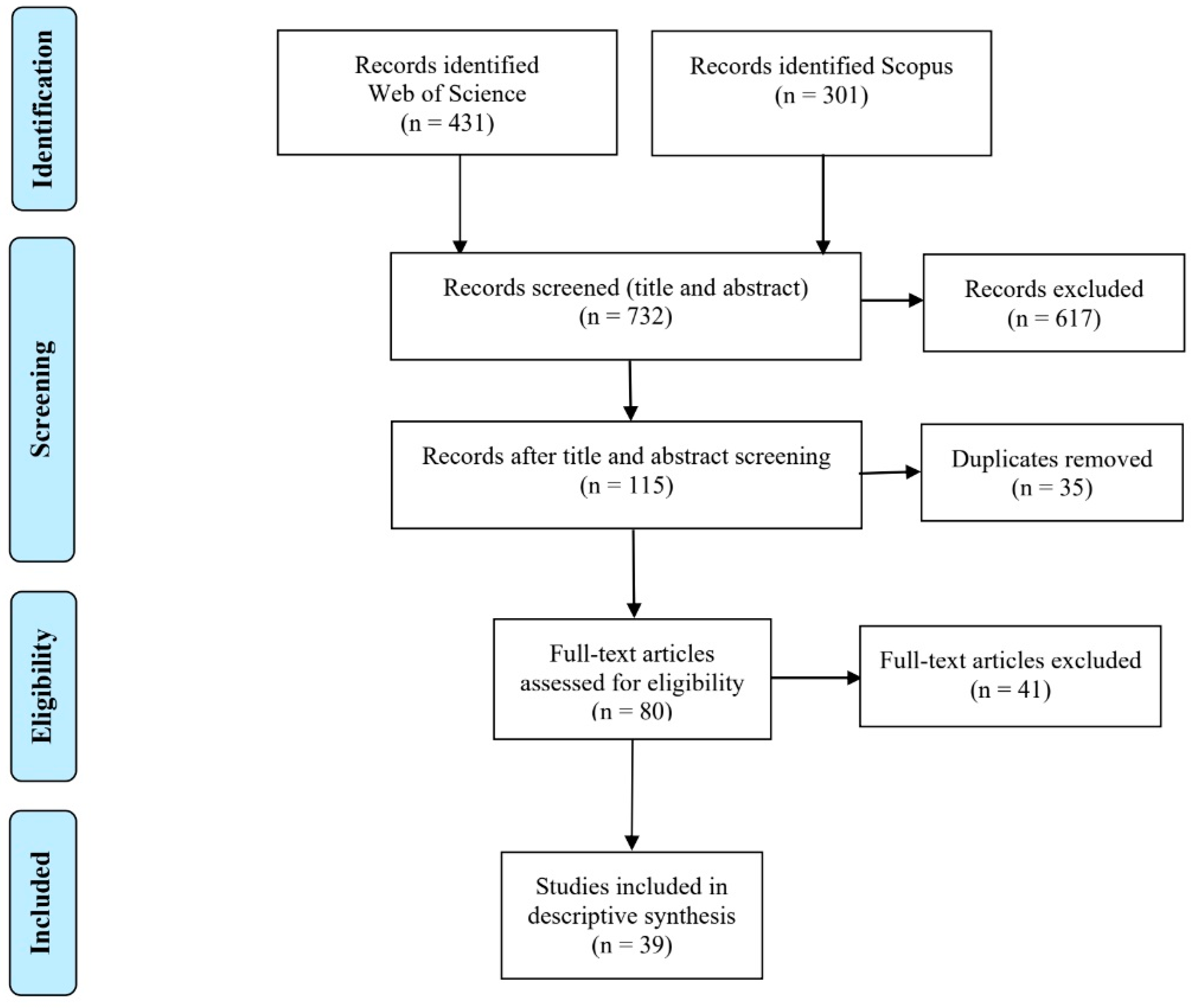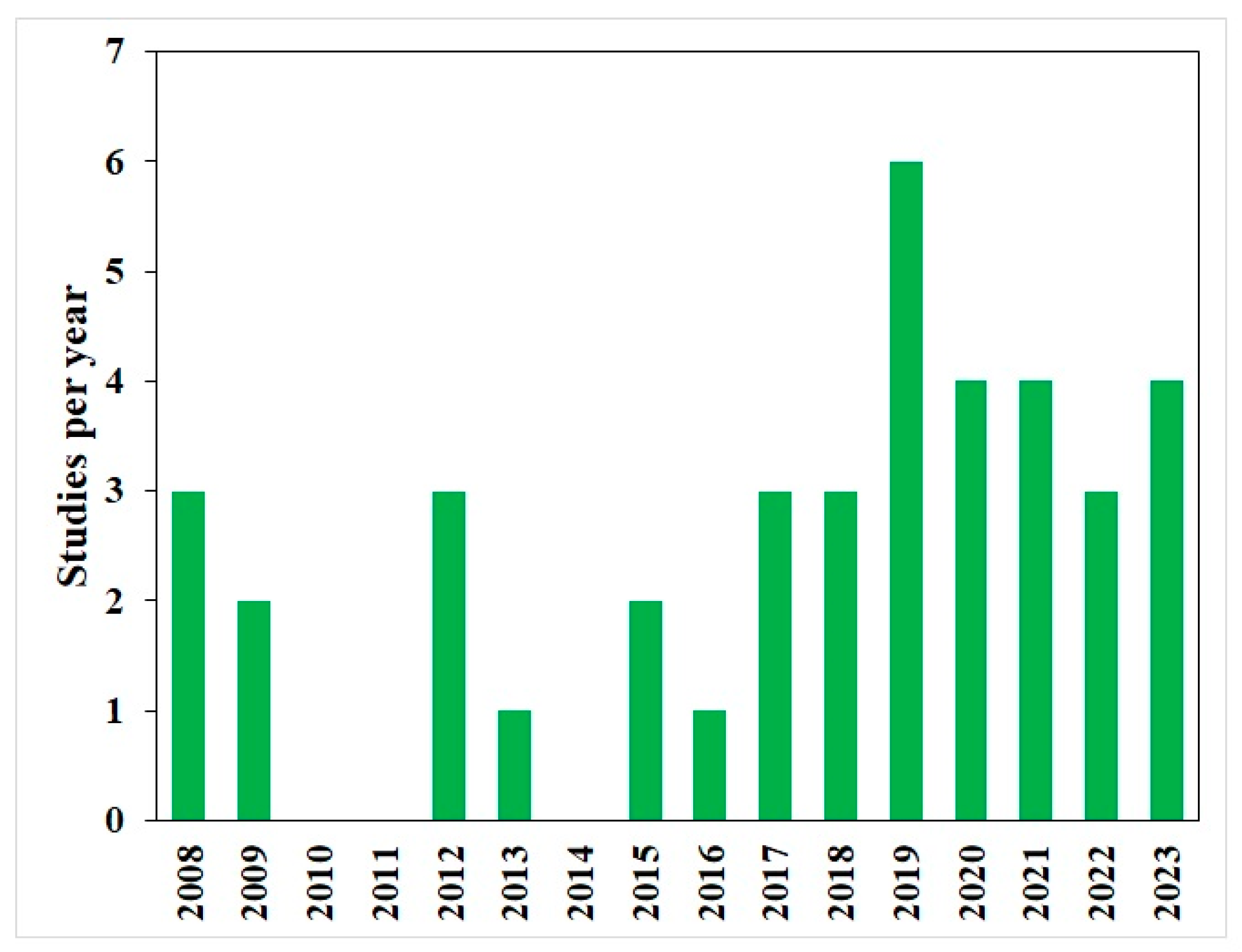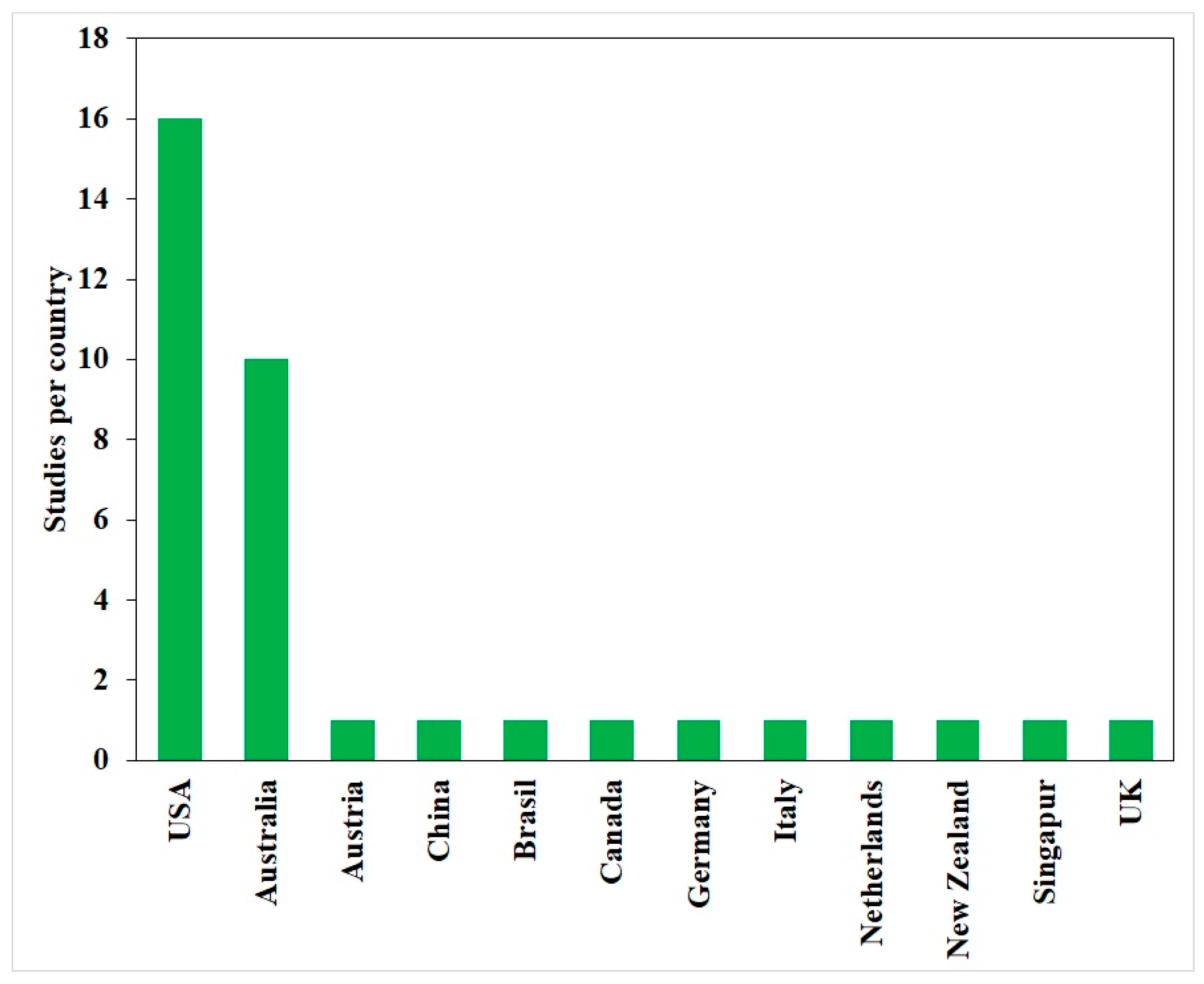Trees in Sponge Cities—A Systematic Review of Trees as a Component of Blue-Green Infrastructure, Vegetation Engineering Principles, and Stormwater Management
Abstract
1. Introduction
- Which vegetation–technical solutions are available for urban tree sites as blue-green infrastructure, and what are the possible advantages and disadvantages for rainwater management and tree health?
2. Materials and Methods
3. Results
3.1. Publication Years, Study Locations and Observation Periods
3.2. BGI Tree Systems
- Cell/suspended pavement systems;
- Structural soils;
- Tree trenches;
- Tree box filters/raingardens/biofilters;
- Rainwater harvesting systems/cisterns;
- Infiltration trenches;
- Permeable pavements.
- An amount of 17 m3 for small, 25.49 m3 for medium and 34 m3 for large tree species (Emeryville, CA, USA);
- An amount of 31.15 m3 for individual tree pits and 15.57 m3 per tree for multiple tree pits (Toronto, ON, Canada);
- An amount of 21.24 m3 per tree (Denver, CO, USA);
- An amount of 28.32 m3 per tree (Charlotte, NC, USA).
3.2.1. Cell/Suspended Pavement Systems
3.2.2. Structural Soils
3.2.3. Rainwater Harvesting Systems/Cisterns
3.2.4. Permeable Pavements
3.2.5. Infiltration Trenches
3.2.6. Tree Box Filters/Raingarden Tree Pits/Biofilters
3.2.7. Tree Trenches
- Reduce the compaction of tree substrates by traffic (and therefore enable rooting);
- Expand the root zone under traffic areas;
- Reduce, delay and retain stormwater runoff;
- Supply trees with more water than usual (increase the catchment area beyond the area of the crown);
- Filter rainwater.
3.3. Hydrologic Performance
3.3.1. Infiltration
3.3.2. Retention
3.3.3. Evapotranspiration
3.4. Tree Health
3.4.1. Root Growth
3.4.2. Stem Diameter Growth
3.4.3. Other Tree Health-Related Factors
3.5. Challenges
3.5.1. De-Icing Salt
3.5.2. Waterlogging
3.5.3. Drought
3.5.4. Clogging
4. Discussion
4.1. Hydrologic Performance
4.2. Tree Health
5. Conclusions
Supplementary Materials
Author Contributions
Funding
Data Availability Statement
Acknowledgments
Conflicts of Interest
References
- Li, Y.; Babcock, R.W., Jr. Green roof hydrologic performance and modeling: A review. Water Sci. Technol. 2014, 69, 727–738. [Google Scholar] [CrossRef]
- Palla, A.; Gnecco, I.; Lanza, L.G. Hydrologic Restoration in the Urban Environment Using Green Roofs. Water 2010, 2, 140–154. [Google Scholar] [CrossRef]
- Beckett, K.P.; Freer-Smith, P.H.; Taylor, G. Urban woodlands: Their role in reducing the effects of particulate pollution. Environ. Pollut. 1998, 99, 347–360. [Google Scholar] [CrossRef]
- Jenerette, G.D.; Harlan, S.L.; Stefanov, W.L.; Martin, C.A. Ecosystem services and urban heat riskscape moderation: Water, green spaces, and social inequality in Phoenix, USA. Ecol. Appl. 2011, 21, 2637–2651. [Google Scholar] [CrossRef]
- Rosenzweig, C.; Solecki, W.; Parshall, L.; Gaffin, S.; Lynn, B.; Goldberg, R.; Cox, J.; Hodges, S. Mitigating New York City’s Heat Island with Urban Forestry, Living Roofs, and Light Surfaces. 2006. Available online: https://www.researchgate.net/publication/242139673_Mitigating_New_York_City’s_heat_island_with_urban_forestry_living_roofs_and_light_surfaces (accessed on 21 October 2019).
- Cipolla, S.S.; Maglionico, M.; Semprini, G.; Villani, V.; Bonoli, A. Green roofs as a strategy for urban heat island mitigation in Bologna (Italy). In International Symposium on Greener Cities for More Efficient Ecosystem Services in a Climate Changing World; Pennisi, G., Cremonini, L., Orsini, F., Gianquinto, G.P., Eds.; ISHS: Leuven, Belgium, 2018; pp. 295–299. ISBN 978-94-62612-12-9. [Google Scholar]
- Embrén, B.; Alvem, B.M.; Stål, A.; Orvesten, A. Planting Beds in the City of Stockholm. A Handbook. 2017. Available online: https://www.biochar.info/docs/urban/Planting_beds_in_Stockholm_2017.pdf (accessed on 4 February 2020).
- Mullaney, J.; Lucke, T.; Trueman, S.J. A review of benefits and challenges in growing street trees in paved urban environments. Landsc. Urban Plan. 2015, 134, 157–166. [Google Scholar] [CrossRef]
- Ballard, W.; Wilson, B.; Udale-Clarke, S.; Illman, H.; Scott; Ashley, T.; Kellagher, R. The SuDS Manual. 2015. Available online: https://www.ciria.org/ItemDetail?iProductCode=C753F&Category=FREEPUBS (accessed on 30 January 2020).
- Bassuk, N.; Denig, B.R.; Haffner, T.; Grabosky, J.; Townbridge, P. CU-Structural Soil. A Comprehensive Guide. 2015. Available online: https://www.hort.cornell.edu/uhi/outreach/pdfs/CU-Structural%20Soil%20-%20A%20Comprehensive%20Guide.pdf (accessed on 31 January 2020).
- Charles River Watershed Stormwater Association. Stormwater, Trees, and the Urban Environment. A Comparative Analysis of Conventional Street Tree Pits and Stormwater Tree Pits for Stormwater Management in Ultra Urban Environments. 2009. Available online: https://studylib.net/doc/18715701/stormwater--trees--and-the-urban-environment (accessed on 9 January 2020).
- Watson, G.W.; Hewitt, A.M.; Custic, M.; Lo, M. The management of tree root systems in urban and suburban settings I: A review of soil influence on root growth. Arboric. Urban For. 2014, 40, 193–217. [Google Scholar] [CrossRef]
- Smiley, E.T.; Calfee, L.; Fraedrich, B.R.; Smiley, E.J. Comparison of Structural and Noncompacted Soils for Trees Surrounded by Pavement. Arboric. Urban For. 2006, 32, 164–169. [Google Scholar] [CrossRef]
- Mullaney, J.; Lucke, T.; Trueman, S.J. The effect of permeable pavements with an underlying base layer on the growth and nutrient status of urban trees. Urban For. Urban Green. 2015, 14, 19–29. [Google Scholar] [CrossRef]
- Savi, T.; Bertuzzi, S.; Branca, S.; Tretiach, M.; Nardini, A. Drought-induced xylem cavitation and hydraulic deterioration: Risk factors for urban trees under climate change? New Phytol. 2015, 205, 1106–1116. [Google Scholar] [CrossRef] [PubMed]
- Ruangpan, L.; Vojinovic, Z.; Di Sabatino, S.; Leo, L.S.; Capobianco, V.; Oen, A.M.; McClain, M.E.; Lopez-Gunn, E. Nature-based solutions for hydro-meteorological risk reduction: A state-of-the-art review of the research area. Nat. Hazards Earth Syst. Sci. 2020, 20, 243–270. [Google Scholar] [CrossRef]
- Probst, N.; Bach, P.M.; Cook, L.M.; Maurer, M.; Leitão, J.P. Blue Green Systems for urban heat mitigation: Mechanisms, effectiveness and research directions. Blue-Green Syst. 2022, 4, 348–376. [Google Scholar] [CrossRef]
- Grey, V.; Livesley, S.J.; Fletcher, T.D.; Szota, C. Tree pits to help mitigate runoff in dense urban areas. J. Hydrol. 2018, 565, 400–410. [Google Scholar] [CrossRef]
- Berland, A.; Shiflett, S.A.; Shuster, W.D.; Garmestani, A.S.; Goddard, H.C.; Herrmann, D.L.; Hopton, M.E. The role of trees in urban stormwater management. Landsc. Urban Plan. 2017, 162, 167–177. [Google Scholar] [CrossRef]
- Elliott, R.M.; Adkins, E.R.; Culligan, P.J.; Palmer, M.I. Stormwater infiltration capacity of street tree pits: Quantifying the influence of different design and management strategies in New York City. Ecol. Eng. 2018, 111, 157–166. [Google Scholar] [CrossRef]
- Moher, D.; Liberati, A.; Tetzlaff, J.; Altman, D.G. Preferred reporting items for systematic reviews and meta-analyses: The PRISMA statement. PLoS Med. 2009, 6, e1000097. [Google Scholar] [CrossRef]
- Pullin, A.S.; Frampton, G.K.; Livoreil, B.; Petrokofsky, G. (Eds.) Guidelines and Standards for Evidence synthesis in Environmental Management. Version 5.1. 2022. Available online: www.environmentalevidence.org/information-for-authors (accessed on 28 October 2023).
- Chapman, S.; Watson, J.E.M.; Salazar, A.; Thatcher, M.; McAlpine, C.A. The impact of urbanization and climate change on urban temperatures: A systematic review. Landsc. Ecol. 2017, 32, 1921–1935. [Google Scholar] [CrossRef]
- Westgate, M.J.; Lindenmayer, D.B. The difficulties of systematic reviews. Conserv. Biol. 2017, 31, 1002–1007. [Google Scholar] [CrossRef]
- Johnson, B.A.; Kumar, P.; Okano, N.; Dasgupta, R.; Shivakoti, B.R. Nature-based solutions for climate change adaptation: A systematic review of systematic reviews. Nat. Based Solut. 2022, 2, 100042. [Google Scholar] [CrossRef]
- Tirpak, R.A.; Hathaway, J.M.; Franklin, J.A. Investigating the hydrologic and water quality performance of trees in bioretention mesocosms. J. Hydrol. 2019, 576, 65–71. [Google Scholar] [CrossRef]
- Snep, R.P.H.; Voeten, J.G.W.F.; Mol, G.; Van Hattum, T. Nature Based Solutions for Urban Resilience: A Distinction Between No-Tech, Low-Tech and High-Tech Solutions. Front. Environ. Sci. 2020, 8, 599060. [Google Scholar] [CrossRef]
- Scholz, M.; Uzomah, V.C. Rapid decision support tool based on novel ecosystem service variables for retrofitting of permeable pavement systems in the presence of trees. Sci. Total Environ. 2013, 458, 486–498. [Google Scholar] [CrossRef]
- MacDonagh, P. Large urban trees as stormwater infrastructure: Too good to be true? In Proceedings of the WEFTEC 2012—85th Annual Technical Exhibition and Conference 2012, New Orleans, LA, USA, 29 September–3 October 2012; pp. 87–98. [Google Scholar] [CrossRef]
- Smiley, T. Growing large healthy urban trees. In Proceedings of the WEFTEC 2012—85th Annual Technical Exhibition and Conference 2012, New Orleans, LA, USA, 29 September–3 October 2012; pp. 99–101. [Google Scholar] [CrossRef]
- Tirpak, R.A.; Hathaway, J.M.; Franklin, J.A.; Kuehler, E. Suspended pavement systems as opportunities for subsurface bioretention. Ecol. Eng. 2019, 134, 39–46. [Google Scholar] [CrossRef]
- Bartens, J.; Day, S.D.; Harris, J.R.; Dove, J.E.; Wynn, T.M. Can Urban Tree Roots Improve Infiltration through Compacted Subsoils for Stromwater Management? J. Environ. Qual. 2008, 37, 2048–2057. [Google Scholar] [CrossRef]
- Grabosky, J.; Bassuk, N. Urban Tree Soil to Safely Increase Rooting Volume. U.S. Patent 5849069A, 15 December 1998. [Google Scholar]
- Ow, L.F.; Chan, E. Deferring waterlogging through stormwater control and channelling of runoff. Urban For. Urban Green. 2021, 65, 127351. [Google Scholar] [CrossRef]
- Siering, N.; Gruening, H. Stormwater Tree Pits for Decentralized Retention of Heavy Rainfall. Water 2023, 15, 2987. [Google Scholar] [CrossRef]
- Nichols, P.W.B.; Lucke, T. Local Level Stormwater Harvesting and Reuse: A Practical Solution to the Water Security Challenges Faced by Urban Trees. Sustainability 2015, 7, 8635–8648. [Google Scholar] [CrossRef]
- Fang, M.; Wang, X.; Liu, J.; Fang, K.; Peng, L.; Deng, Y.; Chen, Y. A new method of interlayer shear performance evaluation for permeable composite pavement (PCP) in laboratory. Constr. Build. Mater. 2023, 408, 133652. [Google Scholar] [CrossRef]
- Lucke, T.; White, R.; Nichols, P.; Borgwardt, S. A Simple Field Test to Evaluate the Maintenance Requirements of Permeable Interlocking Concrete Pavements. Water 2015, 7, 2542–2554. [Google Scholar] [CrossRef]
- Raimondi, A.; Marrazzo, G.; Sanfilippo, U.; Becciu, G. A probabilistic approach to stormwater runoff control through permeable pavements beneath urban trees. Sci. Total Environ. 2023, 905, 167–196. [Google Scholar] [CrossRef] [PubMed]
- Thom, J.K.; Szota, C.; Coutts, A.M.; Fletcher, T.D.; Livesley, S.J. Transpiration by established trees could increase the efficiency of stormwater control measures. Water Res. 2020, 173, 115597. [Google Scholar] [CrossRef] [PubMed]
- Szota, C.; Coutts, A.M.; Thom, J.K.; Virahsawmy, H.K.; Fletcher, T.D.; Livesley, S.J. Street tree stormwater control measures can reduce runoff but may not benefit established trees. Landsc. Urban Plan. 2019, 182, 144–155. [Google Scholar] [CrossRef]
- Tirpak, R.A.; Hathaway, J.M.; Franklin, J.A.; Khojandi, A. The Health of Trees in Bioretention: A Survey and Analysis of Influential Variables. J. Sustain. Water Built Environ. 2018, 4, 04018011. [Google Scholar] [CrossRef]
- Caplan, J.S.; Galanti, R.C.; Olshevski, S.; Eisenman, S.W. Water relations of street trees in green infrastructure tree trench systems. Urban For. Urban Green. 2019, 41, 170–178. [Google Scholar] [CrossRef]
- Kuehler, E.; Hathaway, J.; Tirpak, A. Quantifying the benefits of urban forest systems as a component of the green infrastructure stormwater treatment network. Ecohydrology 2017, 10, e1813. [Google Scholar] [CrossRef]
- Xie, C.; Cai, S.; Yu, B.; Yan, L.; Liang, A.; Che, S. The effects of tree root density on water infiltration in urban soil based on a Ground Penetrating Radar in Shanghai, China. Urban For. Urban Green. 2020, 50, 126648. [Google Scholar] [CrossRef]
- Day, S.D.; Dove, J.E.; Bartens, J.; Harris, J.R. Stormwater management that combines paved surfaces and Urban trees. In GeoCongress 2008: Geosustainability and Geohazard Mitigation; Geotechnical Special Publication; ASCE: Reston, VA, USA, 2008. [Google Scholar] [CrossRef]
- Baker, H.J.; Hutchins, M.G.; Miller, J.D. How robust is the evidence for beneficial hydrological effects of urban tree planting? Hydrol. Sci. J. 2021, 66, 1306–1320. [Google Scholar] [CrossRef]
- Ow, L.F.; Ghosh, S. Urban tree growth and their dependency on infiltration rates in structural soil and structural cells. Urban For. Urban Green. 2017, 26, 41–47. [Google Scholar] [CrossRef]
- Thom, J.K.; Livesley, S.J.; Fletcher, T.D.; Farrell, C.; Arndt, S.K.; Konarska, J.; Szota, C. Selecting tree species with high transpiration and drought avoidance to optimise runoff reduction in passive irrigation systems. Sci. Total Environ. 2022, 812, 151466. [Google Scholar] [CrossRef]
- Szota, C.; McCarthy, M.J.; Sanders, G.J.; Farrell, C.; Fletcher, T.D.; Arndt, S.K.; Livesley, S.J. Tree water-use strategies to improve stormwater retention performance of biofiltration systems. Water Res. 2018, 144, 285–295. [Google Scholar] [CrossRef]
- Livesley, S.J.; Baudinette, B.; Glover, D. Rainfall interception and stem flow by eucalypt street trees—The impacts of canopy density and bark type. Urban For. Urban Green. 2014, 13, 192–197. [Google Scholar] [CrossRef]
- Tirpak, R.A.; Hathaway, J.M.; Franklin, J.A. Evaluating the influence of design strategies and meteorological factors on tree transpiration in bioretention suspended pavement practices. Ecohydrology 2018, 11, e2037. [Google Scholar] [CrossRef]
- Scharenbroch, B.C.; Morgenroth, J.; Maule, B. Tree species suitability to bioswales and impact on the urban water budget. J. Environ. Qual. 2016, 45, 199–206. [Google Scholar] [CrossRef]
- Bassuk, N.; Raffel, G.; Sax, M.S. Root growth of Accolade™ elm in structural soil under porous and nonporous asphalt after twelve years. Arboric. Urban For. 2019, 45, 297–302. [Google Scholar] [CrossRef]
- Fini, A.; Frangi, P.; Mori, J.; Donzelli, D.; Ferrini, F. Nature based solutions to mitigate soil sealing in urban areas: Results from a 4-year study comparing permeable, porous, and impermeable pavements. Environ. Res. 2017, 156, 443–454. [Google Scholar] [CrossRef]
- de la Mota Daniel, F.J.; Day, S.D.; Owen, J.S.; Stewart, R.D. Porous pavement effects on rooting depth and growth of newly planted trees in sidewalk cutouts. Acta Hortic. 2017, 1189, 371–376. [Google Scholar] [CrossRef]
- Ordonez-Barona, C.; Sabetski, V.; Millward, A.A.; Steenberg, J. De-icing salt contamination reduces urban tree performance in structural soil cells. Environ. Pollut. 2018, 234, 562–571. [Google Scholar] [CrossRef] [PubMed]
- Cekstere, G.; Nikodemus, O.; Osvalde, A. Toxic impact of the de-icing material to street greenery in Riga, Latvia. Urban For. Urban Green. 2008, 7, 207–217. [Google Scholar] [CrossRef]
- Equiza, M.A.; Calvo-Polanco, M.; Cirelli, D.; Senorans, J.; Wartenbe, M.; Saunders, C.; Zwiazek, J.J. Long-term impact of road salt (NaCl) on soil and urban trees in Edmonton, Canada. Urban For. Urban Green. 2017, 21, 16–28. [Google Scholar] [CrossRef]
- Gałuszka, A.; Migaszewski, Z.M.; Podlaski, R.; Dołegowska, S.; Michalik, A. The influence of chloride deicers on mineral nutrition and the health status of roadside trees in the city of Kielce, Poland. Environ. Monit. Assess. 2011, 176, 451–464. [Google Scholar] [CrossRef]
- Snieskiene, V.; Balezentiene, L.; Stankeviciene, A. Urban salt contamination impact on tree health and the prevalence of fungi agent in cities of the central Lithuania. Urban For. Urban Green. 2016, 19, 13–19. [Google Scholar] [CrossRef]
- Czerniawska-Kusza, I.; Kusza, G.; Duzynski, M. Effect of deicing salts on urban soils and health status of roadside trees in the Opole region. Environ. Toxicol. 2004, 19, 296–301. [Google Scholar] [CrossRef] [PubMed]
- Eimers, M.C.; Croucher, K.N.; Raney, S.M.; Morris, M.L. Sodium accumulation in calcareous roadside soils. Urban Ecosyst. 2015, 18, 1213–1225. [Google Scholar] [CrossRef]
- Kargar, M.; Jutras, P.; Clark, O.G.; Hendershot, W.; Prasher, S.O. Macro-nutrient availability in surface soil of urban tree pits influenced by land use, soil age, and soil organic matter content. Urban Ecosyst. 2015, 18, 921–936. [Google Scholar] [CrossRef]
- Day, S.D.; Wiseman, P.E.; Dickinson, S.B.; Harris, J.R. Contemporary concepts of root system architecture of urban trees. Arboric. Urban For. 2010, 36, 149–159. [Google Scholar] [CrossRef]
- Franco, J.A.; Banon, S.; Vicente, M.J.; Miralles, J.; Martínez-Sánchez, J.J. Root development in horticultural plants grown under abiotic stress conditions—A review. J. Hortic. Sci. Biotechnol. 2011, 86, 543–556. [Google Scholar] [CrossRef]
- Hanley, P.A.; Livesley, S.J.; Fletcher, T.D.; Szota, C. Water use strategy determines the effectiveness of internal water storage for trees growing in biofilters subject to repeated droughts. Sci. Total Environ. 2023, 894, 164762. [Google Scholar] [CrossRef]
- Glaister, B.J.; Fletcher, T.D.; Cook, P.L.M.; Hatt, B.E. Interactions between design, plant growth and the treatment performance of stormwater biofilters. Ecol. Eng. 2017, 105, 21–31. [Google Scholar] [CrossRef]
- Erickson, A.J.; Gulliver, J.S.; Kang, J.H.; Weiss, P.T.; Wilson, C.B. Maintenance for stormwater treatment practices. J. Contemp. Water Res. Educ. 2010, 146, 75–82. [Google Scholar] [CrossRef]
- Grey, V.; Livesley, S.J.; Fletcher, T.D.; Szota, C. Establishing street trees in stormwater control measures can double tree growth when extended waterlogging is avoided. Landsc. Urban Plan. 2018, 178, 122–129. [Google Scholar] [CrossRef]
- Thives, L.P.; Ghisi, E.; Longo, G.; Hammes, G.; Belotto, T. Performance of Permeable Pavement to Filter Stormwater Runoff for Non-Potable Uses in Buildings. Eur. J. Sustain. Dev. 2023, 12, 80. [Google Scholar] [CrossRef]
- Saadeh, S.; Ralla, A.; Al-Zubi, Y.; Wu, R.; Harvey, J. Application of fully permeable pavements as a sustainable approach for mitigation of stormwater runoff. Int. J. Transp. Sci. Technol. 2019, 8, 338–350. [Google Scholar] [CrossRef]
- Nguyen, P.T.-H.; Kim, J.; Ahn, J. TSS Removal Efficiency and Permeability Degradation of Sand Filters in Permeable Pavement. Materials 2023, 16, 3999. [Google Scholar] [CrossRef] [PubMed]
- Brown, R.A.; Hunt, W.F. Underdrain configuration to enhance bioretention exfiltration to reduce pollutant loads. J. Environ. Eng. 2011, 137, 1082–1091. [Google Scholar] [CrossRef]
- Eckart, J.; Dickhaut, W.; Richter, M. Adapting urban streets for climate change. In REAL CORP 2023: Let It Grow, Let Us Plan, Let It Grow Nature-Based Solutions for Sustainable Resilient Smart Green and Blue Cities; Real Corp: Ljubljana, Slovenia, 2023; pp. 979–984. ISBN 978-3-9504945-2-5. [Google Scholar]
- Kluge, B.; Pallasch, M.; Geisler, D.; Huebner, S. Street trees and decentralized infiltration as a contribution to water-sensitive urban development—Part 1. Corresp. Wastewater Waste 2022, 69, 358–376. (In German) [Google Scholar]





Disclaimer/Publisher’s Note: The statements, opinions and data contained in all publications are solely those of the individual author(s) and contributor(s) and not of MDPI and/or the editor(s). MDPI and/or the editor(s) disclaim responsibility for any injury to people or property resulting from any ideas, methods, instructions or products referred to in the content. |
© 2024 by the authors. Licensee MDPI, Basel, Switzerland. This article is an open access article distributed under the terms and conditions of the Creative Commons Attribution (CC BY) license (https://creativecommons.org/licenses/by/4.0/).
Share and Cite
Richter, M.; Heinemann, K.; Meiser, N.; Dickhaut, W. Trees in Sponge Cities—A Systematic Review of Trees as a Component of Blue-Green Infrastructure, Vegetation Engineering Principles, and Stormwater Management. Water 2024, 16, 655. https://doi.org/10.3390/w16050655
Richter M, Heinemann K, Meiser N, Dickhaut W. Trees in Sponge Cities—A Systematic Review of Trees as a Component of Blue-Green Infrastructure, Vegetation Engineering Principles, and Stormwater Management. Water. 2024; 16(5):655. https://doi.org/10.3390/w16050655
Chicago/Turabian StyleRichter, Michael, Kirya Heinemann, Nadine Meiser, and Wolfgang Dickhaut. 2024. "Trees in Sponge Cities—A Systematic Review of Trees as a Component of Blue-Green Infrastructure, Vegetation Engineering Principles, and Stormwater Management" Water 16, no. 5: 655. https://doi.org/10.3390/w16050655
APA StyleRichter, M., Heinemann, K., Meiser, N., & Dickhaut, W. (2024). Trees in Sponge Cities—A Systematic Review of Trees as a Component of Blue-Green Infrastructure, Vegetation Engineering Principles, and Stormwater Management. Water, 16(5), 655. https://doi.org/10.3390/w16050655






